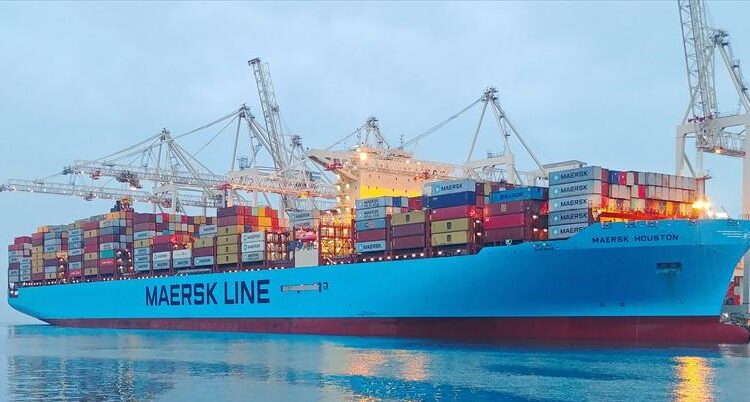
Supply chains ‘finally beginning to stabilise’, says Maersk Asia Pacific market update (March 2023)
COPENHAGEN : While the congestion pressure on global supply chains has eased, inflation and volatility around the world continues to leave logistics planning and execution a task filled with uncertainty. However, as countries, companies and the logistics industry as a whole continue to learn and adapt, supply chains around the world are finally beginning to stabilize and find equilibrium.
Market Trends
PMIs suggest that growth momentum has improved in early 2023, but still remains weak. The global composite PMI experienced a slight rise in January, driven by both manufacturing and services as China reopens and energy prices fall. Manufacturing orders-to-inventory ratio also improved in February, along with manufacturing export orders.
The US inflation rate seems to have hit a peak, but analysts remain uncertain as to when it will come down to the target inflation rate of 2%*.
Europe’s inflation rate, however, is at a record high, increasing rapidly throughout 2022, and may have yet to hit its peak.
Container trade declined from between October to December 2022**, with most regions continuing to experience negative growth.
North America and Europe port congestion continues to decline, while China port congestion continues to fluctuate.
Digitalization continues to create benefits for supply chains
Digitalization of logistics is one of the biggest drivers of growth for retail and manufacturing, positively impacting efficiency, visibility, customer service, flexibility, resilience and analysis. Despite the known advantages of a digitalized supply chain, a McKinsey study found that the average supply chain only has a digitalization level of 43%, a lower amount when compared to other operational areas.
Post-pandemic, more companies than ever are placing a renewed focus on supply chain digitalization, including choosing logistics partners that possess a highly digitalized logistics service. The benefits of digitalization are far-reaching, including:
- Tracking – The ability to see the current location of every shipment, accurately predict arrival time, see and react to delays, improving accountability with customers.
- Forecasting – Accurate historical data of shipping times, weather, cost, and inventory flow allow for more accurate forecasting of future trends, improving planning and prevention of risk.
- Collaboration – Most supply chains involve multiple parties, and the capability for each party to access the same information improves collaboration and accountability.
- Flexibility – Intermodal shipping allows for greater flexibility, and real-time visibility helps you see when you need to make a change to a shipping mode.
- Resilience – Visibility, collaboration, multimodal shipping, integration, and forecasting all help improve resilience, but each and every one of these is in turn improved by digitalization. Unsurprisingly, a study performed by the International Monetary Fund found that companies with stronger digitalization experienced a smaller negative impact from the Covid-19 pandemic
Trade Outlook
Major economies performed better than anticipated in the fourth quarter of 2022 thanks to falling energy prices, a warm winter and China’s reopening. Declining headline inflation, strong fiscal support, consumer confidence off its lows and carryover growth from 2022 have led forecasters to moderately lift the 2023 outlook. However, this does not mean the global economy is back to normal. Global economic growth will be below 2% in 2023 (Maersk Official Anticipation of 2023 global GDP growth: 1.5%). Moreover, the current pull comes from the service sector.
If the global economy has until now avoided a recession, the manufacturing sector has not. All indicators point to a contraction in global activity; weaknesses result from the combination of high inventories, especially in North Europe, and low confidence in future consumer demand.
Viewed from the point of view of the consumer, the outlook sends mixed signals. In the US and Europe, an exceptionally strong labour market is supporting job security. However, declining but still high inflation creates a material loss in purchasing power and a need for yet higher interest rates, and therefore the concern about a decline in consumption once savings are exhausted.
Downside risks are not in short supply though: concerns exist about financial stability of some large US cities and the non-bank financial sector as interest rates continue to rise and cities face significant revenue loss. Moreover, while inflation has so far eased without precipitating a recession, the road to the Fed’s 2% target is still long and narrow, and a US consumer goods spending reset could be much deeper and longer than assumed in our baseline.
As the markets remain volatile through Q1, it is clear that demand for new solutions are increasing. Digitalization of logistics is one of the biggest opportunities in a volatile market, and Maersk remain focused on developing tools that can support our customers improve efficiency, visibility, customer service, flexibility, resilience and analysis.
Ann-Sophie Zerlang Karlsen
Head of Asia Pacific Ocean Customer Logistics
Major economies, including Europe and the US, continue to report positive signs, while Asia-Pacific continue to lead all regions in growth. As Mainland China continues to reopen we are monitoring the market volume recovery closely and making adjustments as needed.
Ports see less congestion in Asia and Europe, and improving weekly in the United States. The equipment situation remains healthy overall.
Maersk believes supply chains “are finally beginning to stabilise and find equilibrium”.
Indeed, its Asia-Pacific March update is generally upbeat, advising that demand across its network is either stronger, or is about to strengthen, particularly on secondary trades.
However, it said that consumers were receiving “mixed signals” on the state of their economies, and that weaknesses from the combination of high inventories – especially in North Europe – and low confidence in future consumer demand were a negative influence.
Picking out the positives, it said intra-Asia demand was “healthy” and that its services were “running at high to full capacity in most sectors”. Asia-Africa volumes were “picking up” and, as a consequence, African services blanked after the Chinese New Year were being resumed.
